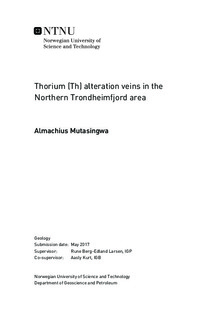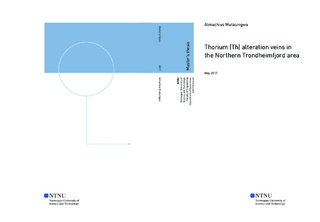| dc.description.abstract | Th-alteration of red carbonate veins within Ytterøy island in the northern Trondheimfjord area was investigated by focusing on field work, mineral chemistry and geochemistry. The principal aim of this thesis was to evaluate the chemistry and mineralogy of the Th-alteration in the red carbonate veins. Modal mineralogy of rocks was obtained from X-ray Diffractometry (XRD), mineral chemistry from Scanning Electron Microscope (SEM) and Electron Micro Probe Analysis (EPMA) analyses. Whole-rock and trace element of samples were obtained from Inductively-Coupled Mass Spectrometry (ICP-MS). Red carbonate veins are dominated by mineral assemblages of quartz, calcite, dolomite, ankerite, barite, microcline, epidote and hornblende whilst the lamprophyre dyke is dominated by mineral assemblages of hornblende, calcite, epidote, titanite and microcline. EPMA analyses indicate that thorogummite is the main Th source in the red carbonate veins. Overall, thorium content in samples is not equally distributed because of variable hydrothermal fluid chemistries and this has led to chemical variation even in a single phase. Thorogummite phase is highly enriched with Th up to 62.4 wt% Th whilst the red carbonate veins contains up to 77.2 wt% ThO2. Similarly, Geiger Muller has detected some traces of Th concentration in some samples (up to 8 µsv/h) during the field work. Thorogummite is highly enriched with ThO2 concentrations and contains relatively low uranium concentration. Thorium enrichment is thought to have occurred because of hydrothermal alteration of thorite/or Th-rich minerals and influx of external fluid rich in thorium mineralization. Hydrothermal fluids are considered to facilitate leaching and transportation of Th either from alkaline igneous complexes and/or granite rocks located at depth or near to the country rocks. High concentration of Th was observed in the thorogummite phase whilst feldspars, carbonates, sulfates, sulfides, and other silicates (i.e. epidote, hornblende, titanite) contains less/no thorium concentration. The lamprophyre dyke contains no thorogummite phase, but show some traces of thorium.
Based on geochemistry of samples, red carbonate veins are depleted in LREE mineralization whilst Lamprophyre dyke is enriched with LREE. Exception was observed in sample AM-16-003B and AM-16-007 (red carbonate vein respectively) were their REE patterns trends similar to those observed in the lamprophyre dyke. However, the fromer samples contains low REE concentrations. It was considered that, both red carbonate and lamprophyre dyke samples could have been enriched from similar process but originate from different source rocks. The distribution of lamprophyre dyke in the study area is highly limited because of being either eroded/extracted and/or poorly exposed. With exception to lamprophyre dyke, Th-alteration in the red carbonate veins is considered to have occurred following early hydrothermal fluids interaction which later precipitated several mineral assemblages. An influx of external fluids rich in Th from a nearby alkaline igneous complex and granite rocks is also important. Both fluids were responsible for leaching, transportation and deposition of different mineral phases which were investigated in samples. Generally, the lamprophyre dyke was slightly affected with hydrothermal fluid interaction since most of its mineral texture were occassionally preserved. | |

